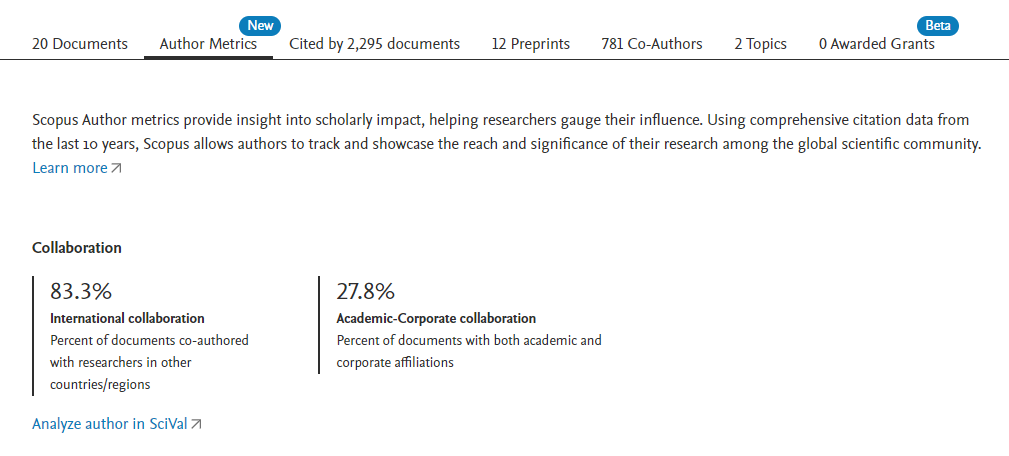New Scopus Author Profile metrics give a more comprehensive picture of research performance
Author profile metrics on Scopus is an innovative new feature to enable researchers to track and showcase a broader array of metrics about their research performance. These metrics go beyond traditional document and citation counts to provide additional context though percentiles and field-weighting; a richer understanding about the author’s role on a paper; and new dimensions such as an author’s international collaboration, and more. This feature aims to help motivate researchers, to better reflect their achievements, and to provide a more comprehensive picture of research performance.
Using comprehensive citation data from the last 10 years, this feature allows authors to track and showcase the reach and significance of their research among the global scientific community, e.g.:
- Collaborations (international, academic-corporate, etc.)
- Documents in top citation percentiles
- Documents in top 25% journals (by CiteScore percentile, Source-normalized Impact per Paper (SNIP) or Scimago Journal Rank (SJR)
Why are we introducing author profile metrics on Scopus?
Researchers need to gather insights about their research performance for a variety of reasons: to understand how their work is being used; to showcase the strength of their team; to apply for funding; or for annual reviews, new roles and promotions. However, researchers face several challenges today:
- The current process is time consuming. When researchers have to spend time pulling together indicators on their research performance, it distracts them from the activities that could be advancing research.
- Researchers must go to several places to pull together a comprehensive picture of their research performance. In addition, there can be several tools which provide different versions of the same metric. This is frustrating and confusing for researchers, who lack a single trustworthy source to track research performance.
- It is difficult to get a comprehensive picture that goes beyond citations and publication counts. While these are important metrics, they miss key nuances about an author’s role, the distribution of citations, or celebrating a researcher's collaborative network. This forces researchers to rely on a narrow set of metrics which incompletely reflect their contribution.
Scopus author metrics solve these problems. This new tab on the author profile page pulls together a wide variety of important metrics about an author’s research performance:
- This new feature saves researchers time by automatically collating research performance metrics about all researchers with a Scopus Author Profile.
- These metrics are available together in one trustworthy source.
- These metrics provide richer information beyond simple citation and publication counts. They show additional insights about academic impact, author position, collaboration, and more.
Elsevier remains committed to the responsible use of metrics
Elsevier continues to innovate and provide researchers with a broad array of metrics to measure and promote their performance. Elsevier supports the careful use of metric and indicators in the evaluation of research and has advocated for a combined qualitative and quantitative approach. Our organization openly supports the Agreement on Reforming Research Assessment. the Declaration on Research Assessment (DORA) and the Leiden Manifesto. When exploring an author’s research output, information in Scopus Author Metrics should be considered along with other available qualitative and quantitative metrics.
What does this feature look like?
The Author Metrics tab appears on the Author Full Profile Page.
The "Collaboration" section provides information on an author's collaboration activity and displays the percentage of the author’s documents that were the result of international collaboration and of academic-corporate collaboration.
"Documents in top citation percentiles" displays the percent of documents in the top 25% most cited documents worldwide.
You can also explore how many articles an author has published in top journals. The "Documents in top 25% journals by..." chart defaults to using CiteScore as an metric. Users can also view this by SNIP or SJR.
"Documents and FWCI" shows an author's document and Field-Weighted Citation Impact (FWCI) history.






